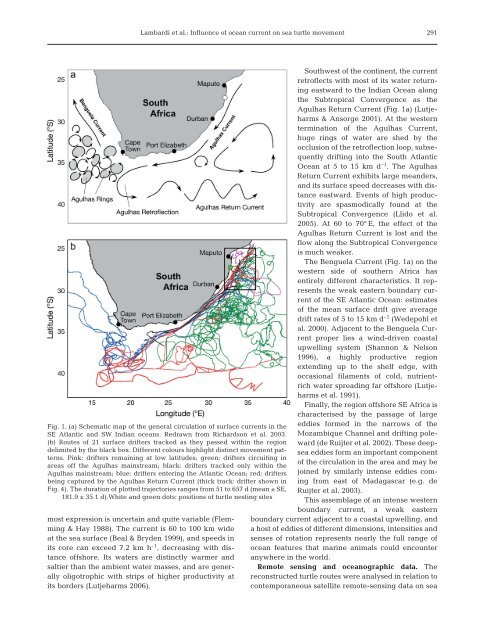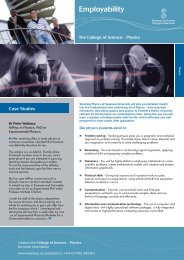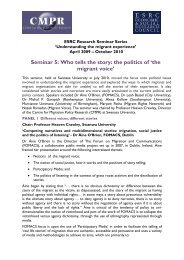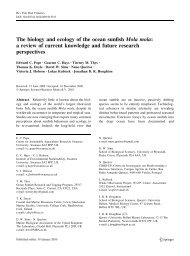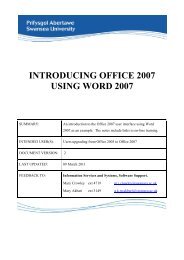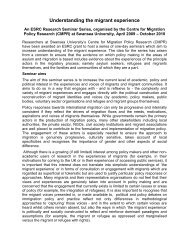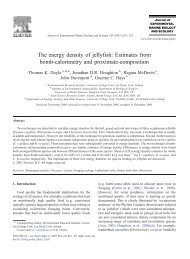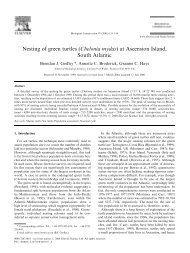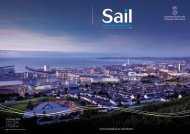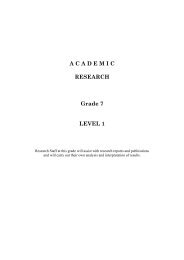Marine Ecology Progress Series 353:289
Marine Ecology Progress Series 353:289
Marine Ecology Progress Series 353:289
You also want an ePaper? Increase the reach of your titles
YUMPU automatically turns print PDFs into web optimized ePapers that Google loves.
Lambardi et al.: Influence of ocean current on sea turtle movement<br />
291<br />
Fig. 1. (a) Schematic map of the general circulation of surface currents in the<br />
SE Atlantic and SW Indian oceans. Redrawn from Richardson et al. 2003.<br />
(b) Routes of 21 surface drifters tracked as they passed within the region<br />
delimited by the black box. Different colours highlight distinct movement patterns.<br />
Pink: drifters remaining at low latitudes; green: drifters circuiting in<br />
areas off the Agulhas mainstream; black: drifters tracked only within the<br />
Agulhas mainstream; blue: drifters entering the Atlantic Ocean; red: drifters<br />
being captured by the Agulhas Return Current (thick track: drifter shown in<br />
Fig. 4). The duration of plotted trajectories ranges from 51 to 657 d (mean ± SE,<br />
181.9 ± 35.1 d).White and green dots: positions of turtle nesting sites<br />
most expression is uncertain and quite variable (Flemming<br />
& Hay 1988). The current is 60 to 100 km wide<br />
at the sea surface (Beal & Bryden 1999), and speeds in<br />
its core can exceed 7.2 km h –1 , decreasing with distance<br />
offshore. Its waters are distinctly warmer and<br />
saltier than the ambient water masses, and are generally<br />
oligotrophic with strips of higher productivity at<br />
its borders (Lutjeharms 2006).<br />
Southwest of the continent, the current<br />
retroflects with most of its water returning<br />
eastward to the Indian Ocean along<br />
the Subtropical Convergence as the<br />
Agulhas Return Current (Fig. 1a) (Lutjeharms<br />
& Ansorge 2001). At the western<br />
termination of the Agulhas Current,<br />
huge rings of water are shed by the<br />
occlusion of the retroflection loop, subsequently<br />
drifting into the South Atlantic<br />
Ocean at 5 to 15 km d –1 . The Agulhas<br />
Return Current exhibits large meanders,<br />
and its surface speed decreases with distance<br />
eastward. Events of high productivity<br />
are spasmodically found at the<br />
Subtropical Convergence (Llido et al.<br />
2005). At 60 to 70° E, the effect of the<br />
Agulhas Return Current is lost and the<br />
flow along the Subtropical Convergence<br />
is much weaker.<br />
The Benguela Current (Fig. 1a) on the<br />
western side of southern Africa has<br />
entirely different characteristics. It represents<br />
the weak eastern boundary current<br />
of the SE Atlantic Ocean: estimates<br />
of the mean surface drift give average<br />
drift rates of 5 to 15 km d –1 (Wedepohl et<br />
al. 2000). Adjacent to the Benguela Current<br />
proper lies a wind-driven coastal<br />
upwelling system (Shannon & Nelson<br />
1996), a highly productive region<br />
extending up to the shelf edge, with<br />
occasional filaments of cold, nutrientrich<br />
water spreading far offshore (Lutjeharms<br />
et al. 1991).<br />
Finally, the region offshore SE Africa is<br />
characterised by the passage of large<br />
eddies formed in the narrows of the<br />
Mozambique Channel and drifting poleward<br />
(de Ruijter et al. 2002). These deepsea<br />
eddies form an important component<br />
of the circulation in the area and may be<br />
joined by similarly intense eddies coming<br />
from east of Madagascar (e.g. de<br />
Ruijter et al. 2003).<br />
This assemblage of an intense western<br />
boundary current, a weak eastern<br />
boundary current adjacent to a coastal upwelling, and<br />
a host of eddies of different dimensions, intensities and<br />
senses of rotation represents nearly the full range of<br />
ocean features that marine animals could encounter<br />
anywhere in the world.<br />
Remote sensing and oceanographic data. The<br />
reconstructed turtle routes were analysed in relation to<br />
contemporaneous satellite remote-sensing data on sea


